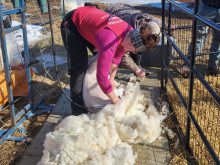Cattle can encounter a multitude of heavy metals and other toxins.
Even with increased education, lead poisoning is still the most common cause of death involving toxins.
Deaths from lead exposure are easily preventable in most cases.
Paints were once lead-based, and leaded gas could end up in used oil. These sources have mostly been eliminated, but burning old buildings that were painted with lead-based paint will still concentrate the lead in the ashes. As a result, it is critical to properly dispose of the ashes and debris.
Read Also

Charges laid after cattle theft
Saskatchewan RCMP lay two charges against a man after six cattle went missing.
Acute lead poisoning is almost always the result of accidentally consuming high concentrations of lead. The number one source of lead is broken down vehicle batteries. The freezing-thawing process will crack old batteries over time, causing them to break down and expose the internal plates.
The plates are salty and attract cattle, particularly calves because of their natural curiosity.
Other sources of lead include the filler used in body work in older vehicles and materials used in the oil patch and left in a junk pile.
Over-shooting animals for butchering with lead bullets can result in meat contamination. A precisely placed head shot with the proper caliber bullet by skilled marksmen is the proper way to kill for butchering. Studies done on hunting submissions have at times found high lead levels.
The lead pieces and fragments congregate in the reticulum (first stomach). The lead is then absorbed into the bloodstream and causes the dramatic signs of toxicity.
The brain is primarily affected, leading to convulsive fits, head pressing, hyperactivity, manic behaviour, blindness and, in most cases, death.
More than one animal is usually involved in battery cases.
Affected animals are often euthanized if found alive and down in a convulsive fit, and a post mortem is done. A veterinarian should be called to rule out other nervous causes of disease.
Once the diagnosis is confirmed, the source of the lead must be found and cleaned up so further cases don’t develop. As well, safeguards need to be put in place to prevent it happening again.
A vet may do several things to confirm the diagnosis. An autopsy may reveal lead pieces in the reticulum and kidneys. The organs can be sent away to confirm a high lead level. Blood can also be checked on live animals. Treatment includes sedatives for hyper animals and calcium ethylenediaminetetraacetic acid to tie up the lead.
I have found that treated animals usually survive, but they are often blind. This raises the issue of whether they can be slaughtered and how long producers must wait from the time the poisoning took place.
Alberta government toxicologists have studied the issue because of recent heavy losses from lead poisoning in feedlots. There are known acceptable lead levels in meat, and the half-life of lead has been calculated to be about two months.
This means it takes two months to excrete half the lead, two months for the next half and so on. The safe time for consumption can then be determined, depending on the amount consumed.
The lead goes into the liver, kidneys and bones, which means euthanasia may be considered depending on intake. Big pieces of lead stay in the rumen and are absorbed continually, which is another cause for euthanasia. Prevention is the key.
Lead poisoning is not a pretty death and the likelihood of successful treatment is poor, even if the animal is found alive. If treatment is successful, producers must still consider the expense of keeping a blind animal around for a long time before they are fit for consumption.
Keep the following points in mind when taking steps to keep cattle and lead batteries apart:
• Have a recycling policy and a temporary storage area for old batteries. Don’t have a huge pile of batteries sitting where cattle can gain access.
• If you use battery powered electric fences, remove the batteries in the fall or have them enclosed where grazing cattle can’t reach.
• When you move cattle to new pastures, check thoroughly for old yard sites, junk piles and deserted vehicles where batteries may be found.
• Change batteries in a shop and immediately store the old battery somewhere safe.
• Pass the word about the danger of lead in batteries.
• Be on the lookout for discarded batteries in and around yard sites. You may inadvertently find other sources of poisons such as bags of urea, soil sterility sprays and other materials that could have toxic effects on all animals, including wildlife.
• When changing batteries in vehicles, immediately remove the old one to a secure storage site.
There have been a few catastrophic incidences of lead poisoning.
In one incident, many cases occurred at a feedlot where evidence suggests a large implement battery was mistakenly ground up through a feed mixer and fed to cattle. It is alarming how many cattle can be killed by one vehicle battery. An innocent mistake had disastrous consequences for the feedlot.
















